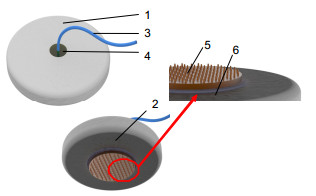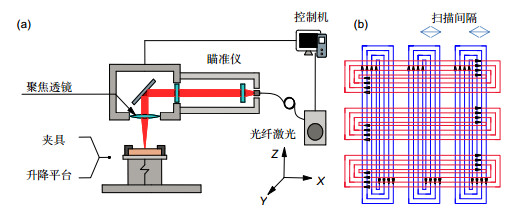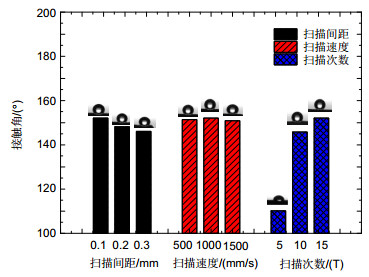Fabrication and bacterial adhesion of metal dry electrode with surface microstructure arrays
-
摘要:
为开发出高性能生物医用干式电极,提出了利用激光微铣-重铸加工方法,实现了表面具有微结构阵列特征的新型金属干式电极的制造成形。在分析电极表面微观形貌的基础上,研究了电极表面的润湿性能,并重点研究了扫描间距、扫描速度和扫描次数等加工参数对大肠杆菌粘附性能的影响规律。研究结果表明:在一定工艺参数条件下所加工出具有微结构阵列特征的电极的接触角可达150°以上,表现出超疏水的特性。在不同扫描间隙和扫描次数条件下加工出的电极对大肠杆菌的粘附性能具有较大影响,在选择0.1 mm扫描间隙时,电极表面粘附的大肠杆菌数量最少,适当增加扫描次数,也能够有效地减少电极表面大肠杆菌的粘结,从而发挥较好的抗菌效果。通过改变扫描速度加工出的电极则对大肠杆菌的粘附性能影响不大。
 Abstract:
Abstract:To develop a high performance biomedical dry electrode, the laser micromilling-recasting technology is used to fabricate the metal dry electrode with surface micostructure arrays. Based on the analysis of the micro morphology of the electrode surface, the wettability of the electrode surface is discussed, and then the influence of laser processing parameters such as scanning spacing, scanning speed and scan times on the adhesion performance of Escherichia coli is further investigated. The results show that the contact angle of metal dry electrode with surface microstructure arrays fabricated with reasonable laser processing parameter can reach more than 150° and show the superhydrophobic characteristics. The adhesion performance of escherichia coli of electrode is changed greatly with different scanning spacing and scan times. When the 0.1 mm scanning spacing is selected, the least amount of escherichia coli is found on the surface of electrode. With the increasing scan times, the adhesion amount of escherichia coli can be reduced. However, the scanned speed has little effect on the adhesion performance of escherichia coli for metal dry electrode.
-
Key words:
- metal dry electrode /
- surface microstructure /
- adhesion performance /
- wettability
-

Biomedical electrodes can convert ion potential of the human body into external electron potential, which are widely used in medical detection and clinical applications such as electrocardiogram (ECG), electromyogram (EMG), electroencephalogram (EEG) and bioelectrical impedance (EIT), etc. Conventional Ag/AgCl wet electrodes usually have conductive gel on its surface and stable signal baseline. However, the conductive gel is easy to gradually dry up and cause allergic phenomenon. Thus, the Ag/AgCl wet electrodes are not suitable for long-time measurement and monitoring of bioelectric signals. Microneedles electrodes can overcome the shortcomings of the Ag/AgCl wet electrode, which can contact the tissue with lower impedance, to improve the quality of bioelectrical signal detection. In this study, the laser milling-recasting technology was proposed to fabricate metal dry electrodes with surface microstructure arrays. Based on the analysis of the microcosmic appearance of the electrode surface, the wettability of the electrode surface were firstly discussed, and then the influence of scanning spacing, scanning speed and scanning times of laser processing parameters on the adhesion of Escherichia coli were further investigated. The results show that the contact angle of metal dry electrode with surface microstructure arrays fabricated with reasonable laser processing parameter could reach more than 150° and showed the superhydrophobic characteristics. With the scanning spacing of 0.1 mm, the smallest averager radius of microstructure on the surface of the metal dry electrode was obtained to limit the biofilm growth, which showed the best performance against the adhesion of Escherichia coli. However, the metal dry electrode adhered more Escherichia coli when the larger scanning spacing was selected. When small scanning times was selected, the metal dry electrodes had much lower height of the surface microstructure, and the larger adhesion amount of escherichia coli was obtained due to its poorer hydrophobicity. With the increasing scanning times, the adhesion amount of escherichia coli of metal dry electrode can be reduced. The scanned speed has little influence on the hydrophobicity and the adhesion ability of Escherichia coli because the shape of the microstructure was not changed greatly with different scanning speeds. Taking into account the performance and economic requirements of the metal dry electrode, the optimized processing parameters including 0.1 mm scanning spacing, 1000 mm/s scanning speed, 15 scanning times and 25 W laser output power were recommend. The metal dry electrode with surface microstructure arrays shows hydrophobicity characteristics against the adhesion of Escherichia coli compared with others bioelectrodes, which have an important application prospects for long-time detection of bioelectricity measurement.
-

-
表 1 激光器的相关参数.
Table 1. Schematic diagram of laser processing system.
相关参数 参数范围 假定值 激光波长/nm 1055~1070 1064 激光输出功率/W 29~31 30 脉冲周期/ns 90~120 1 00 脉冲频率/kHz 20~200 20 入射光束直径/mm 6~9 7 聚焦直径/μm 24.3~37.3 31.5 -
[1] Srivastava A K, Bhartia B, Mukhopadhyay K, et al. Long term biopotential recording by body conformable photolithography fabricated low cost polymeric microneedle arrays[J]. Sensor And Actuators A :Physical, 2015, 236(9):164-172. https://www.researchgate.net/publication/283525934_Long_term_biopotential_recording_by_body_conformable_photolithography_fabricated_low_cost_polymeric_microneedle_arrays
[2] 周伟, 刘伟, 邱清富, 等.生物医用电极制造技术及应用研究进展[J].科学通报, 2015, 60(15):1352-1360. http://kns.cnki.net/KCMS/detail/detail.aspx?filename=kxtb201515004&dbname=CJFD&dbcode=CJFQ
Zhou Wei, Liu Wei, Qiu Qingfu, et al. Development, fabrication, and applications of biomedical electrodes[J]. Chinese Science Bulletin, 2015, 60(15):1352-1360. http://kns.cnki.net/KCMS/detail/detail.aspx?filename=kxtb201515004&dbname=CJFD&dbcode=CJFQ
[3] 石恒冲, 殷敬华.医用高分子材料抗菌表面构建及在医疗器械中应用[J].高分子通报, 2016(9): 196-202. http://kns.cnki.net/KCMS/detail/detail.aspx?filename=gfzt201609026&dbname=CJFD&dbcode=CJFQ
Shi Hengchong, Yin Jinghua. Surface construction of antibacterial property on biomedical polymer materials and its application on medical device[J]. Polymer Bulletin, 2016(9): 196-202. http://kns.cnki.net/KCMS/detail/detail.aspx?filename=gfzt201609026&dbname=CJFD&dbcode=CJFQ
[4] 王章明, 孙伟, 田修波, 等.抗菌表面处理技术研究进展[J].材料科学与工程学报, 2006, 24(5): 787-791. http://d.wanfangdata.com.cn/Periodical_clkxygc200605039.aspx
Wang Zhangming, Sun Wei, Tian Xiubo, et al. Progress in antibacterial field by surface modification[J]. Journal of Materials Science & Engineering, 2006, 24(5): 787-791. http://d.wanfangdata.com.cn/Periodical_clkxygc200605039.aspx
[5] Yuan Yue, Hays M P, Hardwidge P R, et al. Surface characteristics influencing bacterial adhesion to polymeric substrates[J]. RSC Advances, 2017, 7(23): 14254-14261. doi: 10.1039/C7RA01571B
[6] Jiang You, Yin Yijie, Zha Xincheng, et al. Wettability regulated gram-negative bacterial adhesion on biomimetic hierarchical structures[J]. Chinese Chemical Letters, 2017, 28(4): 813-817. doi: 10.1016/j.cclet.2016.08.002
[7] Hou Shuyu, Gu Huan, Smith C, et al. Microtopographic patterns affect Escherichia coli biofilm formation on poly(dimethylsiloxane) surfaces[J]. Langmuir, 2011, 27(6): 2686-2691. doi: 10.1021/la1046194
[8] 周锐, 李峰平.纳米颗粒的短脉冲激光烧蚀制备及其非线性光学应用[J].光电工程, 2017, 44(2): 172-184. http://www.oejournal.org/J/OEE/Article/Details/A170317000592/CN
Zhou Rui, Li Fengping. Synthesis of nanoparticles by short pulsed laser ablation and its applications in nonlinear optics[J]. Opto-Electronic Engineering, 2017, 44(2): 172-184. http://www.oejournal.org/J/OEE/Article/Details/A170317000592/CN
[9] Yan Huangping, Abdul Rashid M R B, Khew Si Ying, et al. Realization of laser textured brass surface via temperature tuning for surface wettability transition[J]. Opto-Electronic Engineering, 2017, 44(6): 587-592. http://kns.cnki.net/KCMS/detail/detail.aspx?filename=gdgc201706016&dbname=CJFD&dbcode=CJFQ
[10] Guan Y C, Zhou W, Li Z L, et al. Femtosecond laser-induced ripple structures on magnesium[J]. Applied Physics A, 2014, 115(1): 13-18. doi: 10.1007/s00339-013-7927-5
[11] Lee S W, Shin H S, Chu C N. Fabrication of micro-pin array with high aspect ratio on stainless steel using nanosecond laser beam machining[J]. Applied Surface Science, 2013, 264: 653-663. doi: 10.1016/j.apsusc.2012.10.087
[12] Zhou Wei, Song Rong, Pan Xiaoling, et al. Fabrication and impedance measurement of novel metal dry bioelectrode[J]. Sensors and Actuators A: Physical, 2013, 201: 127-133. doi: 10.1016/j.sna.2013.06.025
[13] Wang Xiao, Li Liyin, Shen Zongbao, et al. Experimental investigation on: Laser shock micro-forming process using the mask and flexible pad[J]. Optics and Lasers in Engineering, 2017, 88: 102-110. doi: 10.1016/j.optlaseng.2016.08.003
[14] Miyagi M, Zhang Xuedong, Kawahito Y, et al. Surface void suppression for pure copper by high-speed laser scanner welding[J]. Journal of Materials Processing Technology, 2017, 240: 52-59. doi: 10.1016/j.jmatprotec.2016.09.008
[15] Zhou Wei, Liu Wei, Liu Shaoyu, et al. Experimental investigation on surface wettability of copper-based dry bioelectrodes[J]. Sensors and Actuators A: Physical, 2016, 244: 237-242. doi: 10.1016/j.sna.2016.04.044
[16] Tang M, Shim V, Pan Z Y, et al. Laser ablation of metal substrates for super-hydrophobic effect[J]. Journal of Laser Micro/Nanoengineering, 2011, 6(1): 6-9. http://www.jlps.gr.jp/jlmn/upload/d31bb775b8a7965380da2982c8641be8.pdf
-


 E-mail Alert
E-mail Alert RSS
RSS

 下载:
下载:












